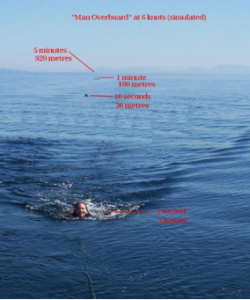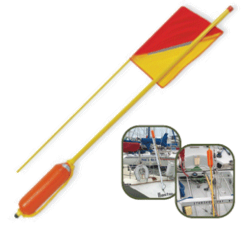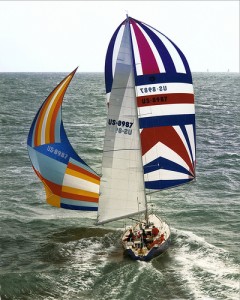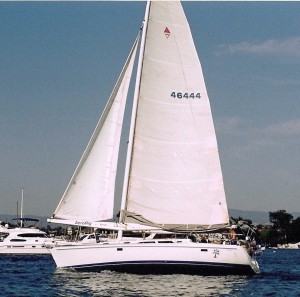Forespar's Point of View
Blogging About Life on the WaterAbout Mike Dwight
View all posts by Mike Dwight
What’s The Yellow Pole with the Orange Flag?
That head in the water is getting away from you at 10 feet per second, and you’re only going six knots. So, in the five seconds it takes you to react, she’s already 55 feet away. 10 seconds, she’s 110 feet astern. If there’s any kind of sea running or a foot of chop, how long before you lose sight of that head, life jacket or not?
Just for training, wad up a paper bag or some wrapping paper, or blow up a balloon to about the size of your head. Toss it over side when you’re under way, and time yourself. It can be hard to find.
That’s why savvy sailors have that yellow pole with the orange cylinder at the base up along the rigging at the back of the boat. It’s a MOB (Man Over Board) pole.
The MOB pole is attached to the stern pulpit at the base, and to the backstay, enclosing the flag at the top. 50 or more feet of line (yellow) is tied to the float on the pole, and the other end to your horseshoe buoy. The picture below shows the basic pole in two parts for shipping, and how it might be mounted.
Deploying the pole is simple – a quick reach back from the helm, lift the pole from its seat, and drop it, reach over, and throw the horseshoe – not necessarily in that order – as long as it’s done quickly.
Now, there’s a high-visibility flag and pole six to ten feet high in the immediate vicinity of your overboard crew. The skipper and crew can track the person the water using the flag, making it much easier to take in sail and get the boat around and back to that flag. You will come up on the windward side of the flag, grab the pole, and reel in the horse shoe with the errant crew member.
A number of sailboats, particularly racers, have an installed horizontal tube, open at the transom. The pole in inserted flag end first, with the line coming out of the transom to the horseshoe. The horseshoe is thrown, and the resulting drag pulls the pole out toward the person in the water.
Many skippers attach a light to the pole. You may not see the pole/flag at night, but you will see the light. Obviously a good idea, and one we’ve used for years of cruising and offshore racing.
Get the pole and install it. You may never need to use it, but if you do, you will need it.
Mike Dwight
Great Reflexes
Closing at more than 40 knots, and no time to trim, duck or do anything except the right thing obviously gets interesting fast. We think this is scary at eight knots. Who was that said “…watching a sailboat race is like watching paint dry.”?
Bloopers
Ocean racing is just about to become more colorful – again!
The new ORR rules are allowing bloopers on non-sprit boats (with some restrictions). For sailors who don’t remember, look at the picture, and check out the big sail tacked to the port bow.
Look at the wake, and the waves, and realize just how deep and fast they’re sailing. Pole back a bit, ease the main a bit, and trim on the the blooper and that boat is still launched – even dead down wind. In light and moderate air, you’ve got a big downwind sail you trim with the halyard. You’ll want a racing crew with someone who either has or can develop a different set of trimming skill, but you’ll make up for it with VMG and boat speed. That blooper helps narrow the gap between an older boat and the sprit boats.
We’ll see them this year on the ocean races such as Bermuda, Transpac and Mackinac.
The ORR rule limits blooper use by treating the blooper as headsail (no pole), and within the number of sails the boat is allowed to carry. It has to be attached to the bow, and there are restraints on the boats allowed to fly them, as in basic design from before 1986. And couple of cautions: Think oscillations. Think about a little too much breeze and an interesting round up or crash jibe.
On the other hand, think speed.
Mike Dwight
By Sailors and For Sailors
Some time there’s a good idea that goes quietly unnoticed except for the insiders. Here’s case in point:
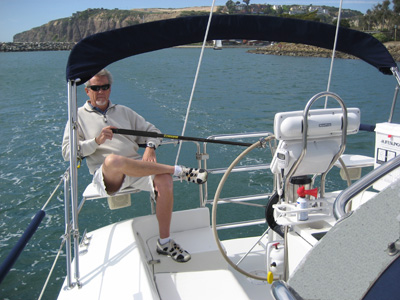
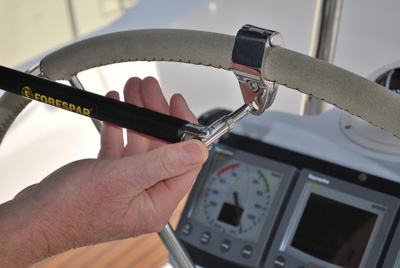
A steering control arm. You want sit comfortably alongside the wheel, where you can see better, and steer with your fingertips. Or you want to get on the rail because its blowing a bit, you want the weight change as well as a better look the the sails.
A quick push button connector lets you attached the arm to your wheel, and when it’s time for real wheel steering, with a couple of seconds it’s off. Better yet, it extends with a twist lock
For that long reach or tack, especially on an lazy day, the steering control arm is just the ticket for a easy sail.
Mike Dwight
Rights of Others on the Water
Not everyone shares your taste in music. Or sports. Or boats. Or recreation. Or wakes. Or engine noise. Or even beverages. Even if they do, they probably don’t want to share right now.
It’s easy to get totally focused on what you’re doing, even in a shared environment. Let’s face it: when you’re cranking along at 25 knots, your attention is on making sure you don’t hit anything solid, and the exhilaration of speed on the water. You’re not looking back at your wake, and seeing how much the swimmers, paddle boarders and kayakers appreciate it. Or how much the waterfront folks enjoy watching their watercraft bang on the dock. And the people out for a quiet day fishing really want to compliment you on your speakers and how loud your motors are.
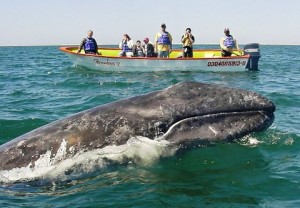 They’re just as happy as you are when you’ve just nestled in to bed after a long day on the water, and someone drops anchor next to you, invites friends, fires up the generator, plugs in the blender and the music, and parties down until the crack of dawn.
They’re just as happy as you are when you’ve just nestled in to bed after a long day on the water, and someone drops anchor next to you, invites friends, fires up the generator, plugs in the blender and the music, and parties down until the crack of dawn.
The long and the short of it is that you ARE in a SHARED environment.
Even the gray whales in Bahia Todos Santos shy away from noisy boaters, and bass in the lakes don’t really flock to rock and roll.
Respect the rights of others. Show some consideration for the people around you.When you’re at the launch ramp or the dock, be quick and make room for the next boat. Respect the private property along the shore. Make sure you have permission to go ashore, use the dock, or cross their land. And so on….
Remember, the other folks in or on the water have the same rights you do. And, just like you, all they want is a good day on the ocean, lake or river.
~ Mike Dwight
Forespar Marelon Plumbing Honored

We are very honored and excited to have been named the 2015 recipient of the Fisheries Supply InNEWvation award in the Plumbing category! Pictured are our own designers John Dean and Art Bandy with the award-winning ClearView End Fittings. Forespar’s composite boat plumbing features the full line of Marelon, from seals and fitting to a full array of valves.
Mike Dwight
Aero Rig – Another Forespar Test
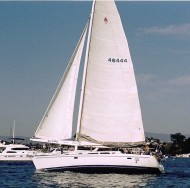
Bob Foresman, Forespar’s founder, never stopped innovating and testing sailing concepts – a company premise that continues today, 50 years later. From the original telescoping whisker poles made in the garage to today’s carbon fiber poles, furling systems and the rest of a catalog of boating products from the modern plant, the family continues to experiment, produce and sell new products.
A classic example is Fore Sail, the Foresman’s Catalina 400. Working with Catalina Yachts, Forespar developed Fore Sail as a test bed for a Forespar-built Aero Rig, with an eye toward a Catalina production model. While this ultimately proved impractical because of market conditions, an easy-to-sail (and single hand) 40-foot cruiser with a very different rig drew a lot of attention in the early 90’s. Shown here with Art Bandy, now the Forespar OEM Sales Manager, at the helm and strings tacking up the Newport Beach Lido Channel.
Check Your Chain Plates
When was the last time you inspected your chainplates? Shrouds and tangs, of course, because they’re easy to see, but the chainplates themselves. If you take the time, and carefully inspect all parts of the rig, you can prevent failures – and losing the rig is at best a bad thing.
Many boat owners, especially those with newer boats, aren’t real sure what a chainplate is, or how essential to the rig they are. Since they provide the foundation of the rig at the base of the shrouds and stays, they’re often masked behind surfaces and seat backs.
They can be hidden or right out in view, as in these pictures from Ericson Yachts
Regardless, they bear huge loads, and are a common point of failure. Remember, stainless is not permanent, and is subject to metal fatigue and corrosion, especially after about ten years. At that point, it becomes a very good idea to inspect the chainplates, fore and aft, side to side, when you’re planning a cruise, and especially if you sail in heavy air or seas. We’ve all “replaced” our standing rigging without a thought to the chainplates.
Look at the photo above. When this happens, your rig gets very unhappy, and so will you. Get down below and take a good hard look at those plates and straps. Or better yet, ask your rigger or a surveyor for an inspection. The worst thing that can happen is nothing, and that’s good.
Mike Dwight
Forespar’s Leisure Furl Launches Website
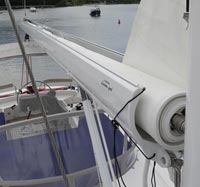
Leisure Furl™ is pleased to announce the launch of its long-anticipated website. Serving offshore and coastal sailors for many years, Leisure Furl™ is today the worldwide leader of in-boom mainsail reefing and furling systems. http://www.leisurefurl.com/
Whether rigged on monohull or multihull, Leisure Furl™ delivers simplicity and ease of use, and unmatched reliability proven on all types of boats, and hundreds of thousands of nautical miles.
Engineered specifically for your boat, Leisure Furl™ offers eight unique models and a multi-factor design program that assures your system will be exactly right for your boat. Available in aluminum or carbon fiber, each boom can be customized with a variety of finishes and power systems.
Pat Dwight
